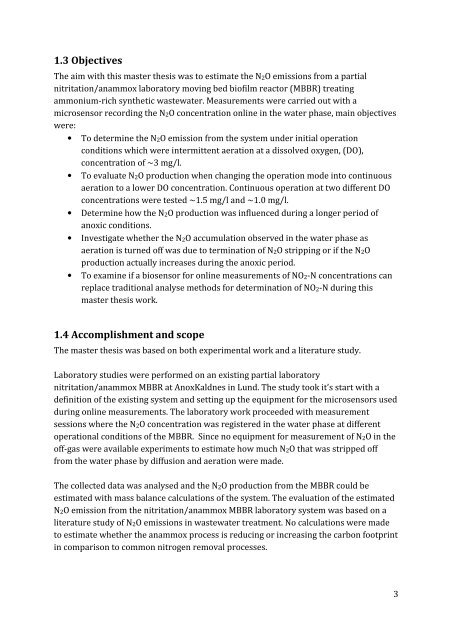N2O production in a single stage nitritation/anammox MBBR process
N2O production in a single stage nitritation/anammox MBBR process
N2O production in a single stage nitritation/anammox MBBR process
Create successful ePaper yourself
Turn your PDF publications into a flip-book with our unique Google optimized e-Paper software.
1.3 Objectives<br />
The aim with this master thesis was to estimate the <strong>N2O</strong> emissions from a partial<br />
<strong>nitritation</strong>/<strong>anammox</strong> laboratory mov<strong>in</strong>g bed biofilm reactor (<strong>MBBR</strong>) treat<strong>in</strong>g<br />
ammonium-rich synthetic wastewater. Measurements were carried out with a<br />
microsensor record<strong>in</strong>g the <strong>N2O</strong> concentration onl<strong>in</strong>e <strong>in</strong> the water phase, ma<strong>in</strong> objectives<br />
were:<br />
• To determ<strong>in</strong>e the <strong>N2O</strong> emission from the system under <strong>in</strong>itial operation<br />
conditions which were <strong>in</strong>termittent aeration at a dissolved oxygen, (DO),<br />
concentration of ~3 mg/l.<br />
• To evaluate <strong>N2O</strong> <strong>production</strong> when chang<strong>in</strong>g the operation mode <strong>in</strong>to cont<strong>in</strong>uous<br />
aeration to a lower DO concentration. Cont<strong>in</strong>uous operation at two different DO<br />
concentrations were tested ~1.5 mg/l and ~1.0 mg/l.<br />
• Determ<strong>in</strong>e how the <strong>N2O</strong> <strong>production</strong> was <strong>in</strong>fluenced dur<strong>in</strong>g a longer period of<br />
anoxic conditions.<br />
• Investigate whether the <strong>N2O</strong> accumulation observed <strong>in</strong> the water phase as<br />
aeration is turned off was due to term<strong>in</strong>ation of <strong>N2O</strong> stripp<strong>in</strong>g or if the <strong>N2O</strong><br />
<strong>production</strong> actually <strong>in</strong>creases dur<strong>in</strong>g the anoxic period.<br />
• To exam<strong>in</strong>e if a biosensor for onl<strong>in</strong>e measurements of NO2-N concentrations can<br />
replace traditional analyse methods for determ<strong>in</strong>ation of NO2-N dur<strong>in</strong>g this<br />
master thesis work.<br />
1.4 Accomplishment and scope<br />
The master thesis was based on both experimental work and a literature study.<br />
Laboratory studies were performed on an exist<strong>in</strong>g partial laboratory<br />
<strong>nitritation</strong>/<strong>anammox</strong> <strong>MBBR</strong> at AnoxKaldnes <strong>in</strong> Lund. The study took it’s start with a<br />
def<strong>in</strong>ition of the exist<strong>in</strong>g system and sett<strong>in</strong>g up the equipment for the microsensors used<br />
dur<strong>in</strong>g onl<strong>in</strong>e measurements. The laboratory work proceeded with measurement<br />
sessions where the <strong>N2O</strong> concentration was registered <strong>in</strong> the water phase at different<br />
operational conditions of the <strong>MBBR</strong>. S<strong>in</strong>ce no equipment for measurement of <strong>N2O</strong> <strong>in</strong> the<br />
off-gas were available experiments to estimate how much <strong>N2O</strong> that was stripped off<br />
from the water phase by diffusion and aeration were made.<br />
The collected data was analysed and the <strong>N2O</strong> <strong>production</strong> from the <strong>MBBR</strong> could be<br />
estimated with mass balance calculations of the system. The evaluation of the estimated<br />
<strong>N2O</strong> emission from the <strong>nitritation</strong>/<strong>anammox</strong> <strong>MBBR</strong> laboratory system was based on a<br />
literature study of <strong>N2O</strong> emissions <strong>in</strong> wastewater treatment. No calculations were made<br />
to estimate whether the <strong>anammox</strong> <strong>process</strong> is reduc<strong>in</strong>g or <strong>in</strong>creas<strong>in</strong>g the carbon footpr<strong>in</strong>t<br />
<strong>in</strong> comparison to common nitrogen removal <strong>process</strong>es.<br />
3















